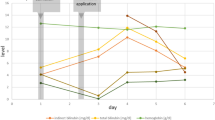Abstract
A patient with idiopathic myelofibrosis is reported who developed a drug fever after treatment with hydroxyurea, a generally effective and well-tolerated drug in chronic myeloproliferative syndromes. Typically, this form of fever develops after a few weeks of exposure to the drug and disappears with discontinuation of the drug. Possible interactions with prostaglandin or leukotriene metabolism may play a role.
Similar content being viewed by others
References
Baumann JL, Pharm D, Shulruff S (1981) Fever caused by hydroxyurea. Arch Intern Med 141:363–368
Berk PD, Goldberg JD, Donovan PB, Fruchtman SM, Berlin NI, Wasserman LR (1986) Therapeutic recommendations in polycythemia vera based on Polycythemia Vera Study Group protocols. Semin Hematol 23:132–143
Blonk MC, Ossenkoppele GJ (1988) Hydroxyurea as a cause of drug fever in chronic myeloid leukaemia. Neth J Med 32:240–242
Donehower RC (1992) An overview of the clinical experience with hydroxyurea. Semin Oncol 19:11–19
Falan DW (1977) Severe reaction to hydroxyurea. Cutis 20:95
Kennedy BJ (1992) The evolution of hydroxyurea therapy in chronic myelogenous leukemia. Semin Oncol 19:21–26
Knapp HR (1990) Reduced allergen-induced nasal congestion and leukotriene synthesis with an orally active 5-lipoxygenase inhibitor. N Engl J Med 323:1745–1748
Lipsky BA, Hirschmann JV (1981) Drug fever. JAMA 245:851–854
Löfvenberg E, Wahlin A (1988) Management of polycythemia vera, essential thrombocythaemia and myelofibrosis with hydroxyurea. Eur J Haematol 41:375–381
Lokich J, Anderson N, Bern M et al (1991) Dual modulation of 5-fluorouracil using leucovorin and hydroxyura. Cancer 68:744–746
McGinn CJ, Kinsella TJ (1992) The experimental and clinical rationale for the use of S-phase-specific radiosensitizers to overcome tumor cell repopulation. Semin Oncol 19:21–28
Murphy ML, Chaube S (1964) Preliminary survey of hydroxy-urea (NSC-32065) as a teratogen. Cancer Chemother Rep 40:1–7
Samuels MI, Howe CD (1964) Renal abnormalities induced by hydroxyurea. Cancer Chemother Rep 40:9–13
Weinfeld A, Swolin B, Westin J (1994) Acute leukaemia after hydroxyurea therapy in polycythaemia vera and allied disorders: prospective study of efficacy and leukaemogenicity with therapeutic implications. Eur J Haematol 52:134–139
Yarbro JW (1992) Mechanism of action of hydroxyurea. Semin Oncol 19:1–10
Author information
Authors and Affiliations
Rights and permissions
About this article
Cite this article
Starmans-Kool, M.J.F., Fickers, M.M.F. & Pannebakker, M.A.G. An unwanted side effect of hydroxyurea in a patient with idiopathic myelofibrosis. Ann Hematol 70, 279–280 (1995). https://doi.org/10.1007/BF01784049
Received:
Accepted:
Issue Date:
DOI: https://doi.org/10.1007/BF01784049




